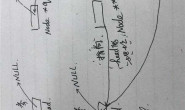1.default:后面可以这样形式吗?也就是说用一个大括号,里面写一些语句,还是只能写一句?
default{
printf("...");
scanf("%d",&n);
break;
}
2.本人有一个可选择的菜单,default是上面那样写的,但是输入字母,会调用相应功能,而不是重新输入。怎么解决啊,谢谢~
解决方案
5
The C switch Statement
The switch and case statements help control complex conditional and branching operations. The switch statement transfers control to a statement within its body.
Syntax
selection-statement :
switch ( expression ) statement
labeled-statement :
case constant-expression : statement
default : statement
Control passes to the statement whose case constant-expression matches the value of switch ( expression ). The switch statement can include any number of case instances, but no two case constants within the same switch statement can have the same value. Execution of the statement body begins at the selected statement and proceeds until the end of the body or until a break statement transfers control out of the body.
Use of the switch statement usually looks something like this:
switch ( expression )
{
declarations
.
.
.
case constant-expression :
statements executed if the expression equals the
value of this constant-expression
.
.
.
break;
default :
statements executed if expression does not equal
any case constant-expression
}
You can use the break statement to end processing of a particular case within the switch statement and to branch to the end of the switch statement. Without break, the program continues to the next case, executing the statements until a break or the end of the statement is reached. In some situations, this continuation may be desirable.
The default statement is executed if no case constant-expression is equal to the value of switch ( expression ). If the default statement is omitted, and no case match is found, none of the statements in the switch body are executed. There can be at most one default statement. The default statement need not come at the end; it can appear anywhere in the body of the switch statement. In fact it is often more efficient if it appears at the beginning of the switch statement. A case or default label can only appear inside a switch statement.
The type of switch expression and case constant-expression must be integral. The value of each case constant-expression must be unique within the statement body.
The case and default labels of the switch statement body are significant only in the initial test that determines where execution starts in the statement body. Switch statements can be nested. Any static variables are initialized before executing into any switch statements.
Note Declarations can appear at the head of the compound statement forming the switch body, but initializations included in the declarations are not performed. The switch statement transfers control directly to an executable statement within the body, bypassing the lines that contain initializations.
The following examples illustrate switch statements:
switch( c )
{
case “A”:
capa++;
case “a”:
lettera++;
default :
total++;
}
All three statements of the switch body in this example are executed if c is equal to “A” since a break statement does not appear before the following case. Execution control is transferred to the first statement (capa++;) and continues in order through the rest of the body. If c is equal to “a”, lettera and total are incremented. Only total is incremented if c is not equal to “A” or “a”.
switch( i )
{
case -1:
n++;
break;
case 0 :
z++;
break;
case 1 :
p++;
break;
}
In this example, a break statement follows each statement of the switch body. The break statement forces an exit from the statement body after one statement is executed. If i is equal to –1, only n is incremented. The break following the statement n++; causes execution control to pass out of the statement body, bypassing the remaining statements. Similarly, if i is equal to 0, only z is incremented; if i is equal to 1, only p is incremented. The final break statement is not strictly necessary, since control passes out of the body at the end of the compound statement, but it is included for consistency.
A single statement can carry multiple case labels, as the following example shows:
case “a” :
case “b” :
case “c” :
case “d” :
case “e” :
case “f” : hexcvt(c);
In this example, if constant-expression equals any letter between “a” and “f”, the hexcvt function is called.
Microsoft Specific —>
Microsoft C does not limit the number of case values in a switch statement. The number is limited only by the available memory. ANSI C requires at least 257 case labels be allowed in a switch statement.
The default for Microsoft C is that the Microsoft extensions are enabled. Use the /Za compiler option to disable these extensions.
END Microsoft Specific
The switch and case statements help control complex conditional and branching operations. The switch statement transfers control to a statement within its body.
Syntax
selection-statement :
switch ( expression ) statement
labeled-statement :
case constant-expression : statement
default : statement
Control passes to the statement whose case constant-expression matches the value of switch ( expression ). The switch statement can include any number of case instances, but no two case constants within the same switch statement can have the same value. Execution of the statement body begins at the selected statement and proceeds until the end of the body or until a break statement transfers control out of the body.
Use of the switch statement usually looks something like this:
switch ( expression )
{
declarations
.
.
.
case constant-expression :
statements executed if the expression equals the
value of this constant-expression
.
.
.
break;
default :
statements executed if expression does not equal
any case constant-expression
}
You can use the break statement to end processing of a particular case within the switch statement and to branch to the end of the switch statement. Without break, the program continues to the next case, executing the statements until a break or the end of the statement is reached. In some situations, this continuation may be desirable.
The default statement is executed if no case constant-expression is equal to the value of switch ( expression ). If the default statement is omitted, and no case match is found, none of the statements in the switch body are executed. There can be at most one default statement. The default statement need not come at the end; it can appear anywhere in the body of the switch statement. In fact it is often more efficient if it appears at the beginning of the switch statement. A case or default label can only appear inside a switch statement.
The type of switch expression and case constant-expression must be integral. The value of each case constant-expression must be unique within the statement body.
The case and default labels of the switch statement body are significant only in the initial test that determines where execution starts in the statement body. Switch statements can be nested. Any static variables are initialized before executing into any switch statements.
Note Declarations can appear at the head of the compound statement forming the switch body, but initializations included in the declarations are not performed. The switch statement transfers control directly to an executable statement within the body, bypassing the lines that contain initializations.
The following examples illustrate switch statements:
switch( c )
{
case “A”:
capa++;
case “a”:
lettera++;
default :
total++;
}
All three statements of the switch body in this example are executed if c is equal to “A” since a break statement does not appear before the following case. Execution control is transferred to the first statement (capa++;) and continues in order through the rest of the body. If c is equal to “a”, lettera and total are incremented. Only total is incremented if c is not equal to “A” or “a”.
switch( i )
{
case -1:
n++;
break;
case 0 :
z++;
break;
case 1 :
p++;
break;
}
In this example, a break statement follows each statement of the switch body. The break statement forces an exit from the statement body after one statement is executed. If i is equal to –1, only n is incremented. The break following the statement n++; causes execution control to pass out of the statement body, bypassing the remaining statements. Similarly, if i is equal to 0, only z is incremented; if i is equal to 1, only p is incremented. The final break statement is not strictly necessary, since control passes out of the body at the end of the compound statement, but it is included for consistency.
A single statement can carry multiple case labels, as the following example shows:
case “a” :
case “b” :
case “c” :
case “d” :
case “e” :
case “f” : hexcvt(c);
In this example, if constant-expression equals any letter between “a” and “f”, the hexcvt function is called.
Microsoft Specific —>
Microsoft C does not limit the number of case values in a switch statement. The number is limited only by the available memory. ANSI C requires at least 257 case labels be allowed in a switch statement.
The default for Microsoft C is that the Microsoft extensions are enabled. Use the /Za compiler option to disable these extensions.
END Microsoft Specific
15
switch里每一个分支(包括default),只要理解为顺序执行的语句系列就可以了(用break可以跳出switch块),不管有多少语句,一般也不需要大括号(除非在分支里面定义局部变量,有些编译器需要在大括号里面)
40
你想有几句都可以,想有几个大括号也都可以
假如想在输入错误后重新输入,可以在default中goto到switch前面




